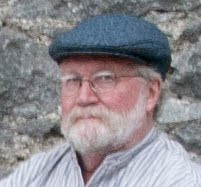 (A larger, higher-resolution image can be downloaded by clicking here... and a truly massive [more than 100 megs!], full-resolution file is available here -- but please come back!)
(A larger, higher-resolution image can be downloaded by clicking here... and a truly massive [more than 100 megs!], full-resolution file is available here -- but please come back!)One of the first people to recognize the spiral structure of M51 was William Parsons, the Third Earl of Rosse, who built the world's largest telescope on his estate in the midlands of Ireland in the early 1840's. His ingenious 72-inch telescope, "The Leviathan of Parsonstown," was to remain the largest (and thus most powerful light-gatherer) on this planet for more than 70 years, a record of persistant dominance not likely to be equalled. Its staggering light-gathering power for the time allowed Lord Rosse to view detail in objects too faint for others' instruments.
 The reconstructed Leviathan of Parsonstown in August, 2006.
The reconstructed Leviathan of Parsonstown in August, 2006.
 Two of Lord Rosse's drawings of M51, done at the eyepiece of the Leviathan, on display in Ireland's Historic Science Centre on the grounds of the Birr Castle Demesne, home to the Third Earl of Rosse's great-great grandson, Brendan Parsons, the Seventh Earl.
Two of Lord Rosse's drawings of M51, done at the eyepiece of the Leviathan, on display in Ireland's Historic Science Centre on the grounds of the Birr Castle Demesne, home to the Third Earl of Rosse's great-great grandson, Brendan Parsons, the Seventh Earl.
 The reconstructed Leviathan of Parsonstown in August, 2006.
The reconstructed Leviathan of Parsonstown in August, 2006. Two of Lord Rosse's drawings of M51, done at the eyepiece of the Leviathan, on display in Ireland's Historic Science Centre on the grounds of the Birr Castle Demesne, home to the Third Earl of Rosse's great-great grandson, Brendan Parsons, the Seventh Earl.
Two of Lord Rosse's drawings of M51, done at the eyepiece of the Leviathan, on display in Ireland's Historic Science Centre on the grounds of the Birr Castle Demesne, home to the Third Earl of Rosse's great-great grandson, Brendan Parsons, the Seventh Earl.M51 permeates the traditions of the Birr Castle Demesne, as Diane and I found during our stay there in August of 2006. In fact, a major, relatively new, facet of the Demesne's lovely and extensive gardens is the "Whirlpool Spiral," a modern variation on the ancient garden maze. It is a spiral of mown pathway and lime trees, laid out in porportion to imitate the appearance of M51A and M51B. I haven't been able to locate an aerial view of the spiral, but here it is in part of the Demesne's visitors' map:
(The spiral is number 13 on the map; number 2 is the reconstructed telescope.)
At the center of the spiral of young lime trees -- at the core of the verdant M51A -- is this pit at the left of the frame:


When I asked the current Lord Rosse about this odd depression, he told me that it was a "siege pit," a place where Jacobite cannon under the command of the Bastard Duke of Berwick were entrenched during the 1600s' War of the Two Kings. Balls from the cannon left marks on Birr Castle that are still visible, and some of the balls compose part of a foyer decoration:


While supermassive black holes at the centers of galaxies may be commonplace, M51 is the only one I know of with a siege pit at its core.
A short slideshow of the Birr Castle Demesne from our visit in August, 2006, can be viewed by clicking here.
A short slideshow of the Birr Castle Demesne from our visit in August, 2006, can be viewed by clicking here.



4 comments:
The next trick would be to create a formula that would evaluate, on the one hand, the optical properties of a lense crafted in 1840 compared to the potential for such a lense crafted with modern techniques ... and then compensate for the fact that the stars he was gazing at were only competing with candles and the occasional rush torch on earth.
Wow. So much information packed into one post.
It's rare that a blog post leaves me gobsmacked (you must have heard the term on your trip to the UK) but this one did. Science, art and history.
Really enjoyed this. Someday I hope to get to the UK and Europe, to tread the soil of my own ancestors. That'll involve sojourns to Ireland, Scotland, France, and even Holland (The family stew includes MacLeods, Campbells, Pardieus, and Hatchers - and we're not genetically Irish, but, coming from Newfoundland, completely culturally Irish). Your trip gives me hope that it'll happen.
Ronnie, you wouldn't believe how much stuff I had to leave *out* of that post -- I'm (seriously) thinking about taking a sabbatical leave to go back into the Castle archives and put something coherent together. It will be a hard job, because the Parsons family has been almost mutantly prolific in all kinds of technological and artistic ways for *centuries*. Efforts have been made before to give them their due, but none has really done them justice. The Third Earl's younger son, Charles Algernon, for example, invented the steam turbine and demonstrated it by running rings around the English fleet, uninvited, at Queen Victoria's diamond jubilee.
Astounding family -- including the current (7th) Earl (a world-famous botanist -- see the "Red Tree Trail" portion of the sharrington.net
website.)
Mike -- your comment deserves a whole separate post!
I enjoyed seeing pictures of your trip and enjoy your writing about astronomy, so it's especially great to see them come together in this post.
Speaking of Lick (huh?), one of the deep sky objects I was fortunate enough to view through the 36-inch refractor was M51 (oh!). Now, I was young but I'd spent enough time around telescopes to be a little jaded, but Holy Cow that sucker knocked my socks off. It almost looked 3-D, like you could crawl through the tube and touch it. I may have actually gasped.
My only other M51 story involves a local astronomical society, which built a very, very nice observatory on state park land nearby. They'd arranged a special fund-raising event, with a Berkeley astronomer giving a little talk to be followed by some observing. Well, the docents running the telescope were trying to dial up M51 via computer and having no luck. My helpful "Dudes, there's the Big Dipper, it's right up there" was not well received while they had the thing pointed 90 degrees the wrong direction. When they finally did locate it, turns out they had the scope outfitted with a CCD and we all got to stand around watching M51 on a computer monitor.
Now, I understand that real astronomers don't actually look through telescopes anymore, and my respect for the contributions electronics and computers have made to astronomy is boundless. But as a public relations event aimed at helping interested laymen connect to the heavens and understand that this observatory was a special place that deserved their support, I thought it was a complete bust. We might as well have been sitting at home looking at Hubble images on the Internet.
And that's why you're important.
Post a Comment